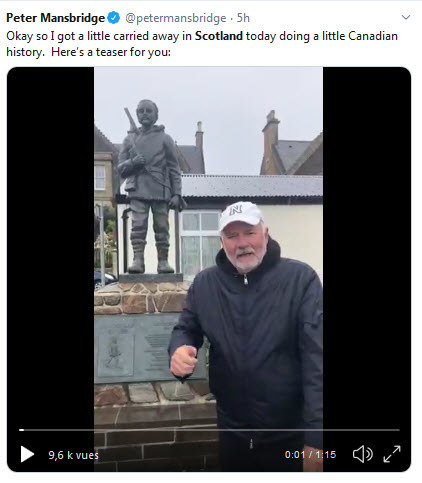While surfing on Twitter, I stumbled upon a video from Peter Mansbridge (documentary film producer – Toronto – Canada) which tweet captured my attention: “Okay, so I got a little carried away in Scotland today doing a little Canadian history. Here’s a teaser for you.”
I watched the video and was delighted to hear about a Canadian-Scottish link in the person of Dr John Rae, an Arctic explorer that discovered an open channel to the east of King William Island in the high arctic. Known today as Rae Strait, it was the missing link in what would become the first navigable Northwest Passage.
Wow!
You can imagine that I then went straight out ‘googling’ the name of Dr John Rae! Happy to share this article found amongst the results pages:
John Rae was born at the Hall of Clestrain, Orphir, on 30th September 1813; one of nine children. His father (also called John) was the estate factor for Lord Armadale, the Lord Advocate of Scotland, who lived in Edinburgh. The young John loved to go shooting wild fowl on the hills and by the shore, or to go fishing and sailing the family’s small boat. This education would serve him well in his future career as an explorer.
Rae studied medicine at Edinburgh University and the Royal College of Surgeons, qualifying in 1833. His father was also the agent for the Hudson’s Bay Company in Stromness, so on his return to Orkney Dr Rae signed on as ship’s surgeon on the Prince of Wales bound for Canada. Rae was forced to winter in Canada when the ship found its return route blocked by ice. He accepted the post of surgeon and clerk at Moose Factory and served there for ten years. He spent his free time hunting and learning travel and survival skills from the First Nation and Metis people; including how to use sleds and snow-shoes.
The Hudson’s Bay Company Governor-in-Chief, Sir George Simpson, identified Rae as the man to finish the mapping of the Arctic coast. Receiving training as a surveyor meant a 1,200 mile walk on snow-shoes before finally reaching his tutor. In his first Arctic expedition of 1846-7, Rae left with a small group of people and carried only a small amount of food, choosing instead to live off the land by means of hunting. They built a stone house, called Fort Hope, but found it unsuitable as it was so cold. He later learnt from the Inuit how to make snow houses, which proved to be warm and reusable. Rae explored the Gulf of Boothia using small boats and on foot, discovering that Boothia was a peninsula and not an island as had been thought.
After a trip to London he returned to the Arctic in 1848 as second in command in Sir John Richardson’s search party looking for the lost Franklin Expedition. In 1849 Richardson returned to England while Rae continued to explore the coastline to Wollaston Land by boat with six men. A third Arctic expedition in 1851 saw the first trace of Franklin’s missing ships when Rae found a piece of wood and a part of a flagstaff containing the remnants of cloth. He was awarded the Founder’s Gold Medal of the Royal Geographical Society in 1852 for his discoveries of 1846–47 and 1851.
Ian Scott’s statue of John Rae in Stromness, Orkney Island, Scotland
His expedition of 1853-4 saw him make the important discovery that King William Land was not a peninsula but an island. His discovery of Rae Strait was the last link in a navigable Northwest Passage from the Atlantic to the Pacific Oceans, which was successfully used by the Norwegian Roald Amundsen in 1903-06. Rae also met Inuit who told him that a party of around 40 white men had died of starvation on King William Island, resorting to cannibalism in a final attempt to stay alive. He returned to London with the sad news of the fate of Sir John Franklin and the crews of his two ships, only to enter a storm of controversy. His unedited report, containing the reports of cannibalism, was issued to The Times by the Admiralty. Lady Franklin rallied support from Charles Dickens who vilified the Inuit as savages and liars in his magazine, Household Words. Lady Franklin destroyed Rae’s reputation, while erecting a bust in Westminster Abbey proclaiming Franklin as the discoverer of the Northwest Passage. Rae was finally awarded the £10,000 reward for news of the fate of the Franklin expedition, which he shared with his party.
He married Catherine (Kate) Thompson in 1860 and worked on surveying the route for a telegraph link from Britain to Canada, via Iceland and Greenland. In 1865 he surveyed the Red River to Victoria for another telegraph link from America to Russia. He retired to Orkney, renting Berstane House to the east of Kirkwall before moving to London. Rae was a highly respected explorer who mapped around 1,750 miles of Arctic coast either on foot or in small boats. His respect of the indigenous peoples of Canada made him many friends there and he is still respected by them to this day. Lady Franklin’s relentless campaign to have him removed from the history of Arctic exploration saw his discoveries attributed to Royal Navy expeditions; an injustice that he robustly fought. He died at his house at 4 Addison Gardens, London, on 22nd July 1893; his body was taken north for burial in the grounds of St Magnus Cathedral. A memorial, paid by public subscription, was erected to him inside the cathedral the following year.
Source: johnraesociety.com
Being a stamp collector at heart, I’ve also searched if any country of the world had commemorated Dr John Rae on a postage stamp. Sadly found none, but a petition to that effect on Change.org six years ago….
There is always hope!
Until next, all the very best,
Janice
From the province of Quebec, in Canada 🙂




Leave a Reply